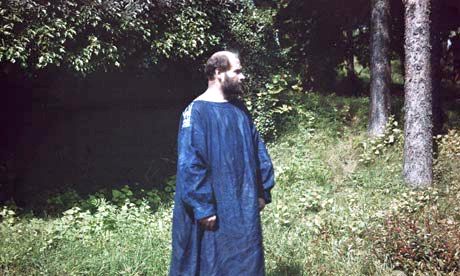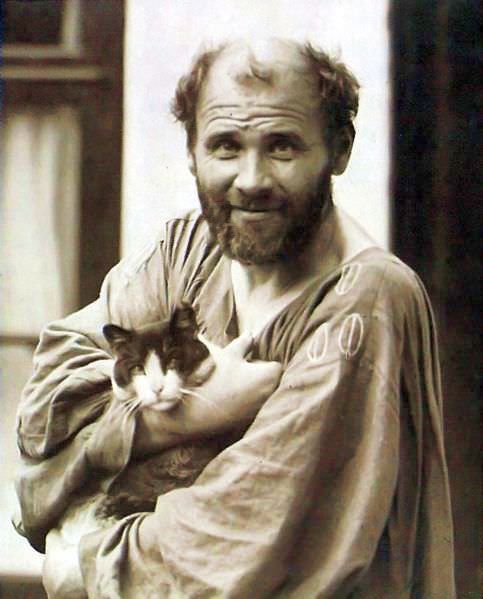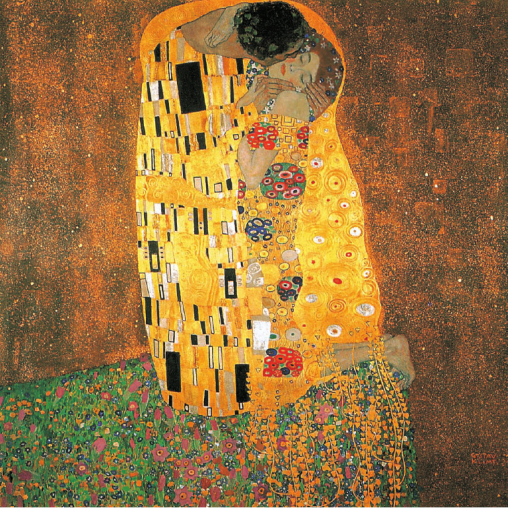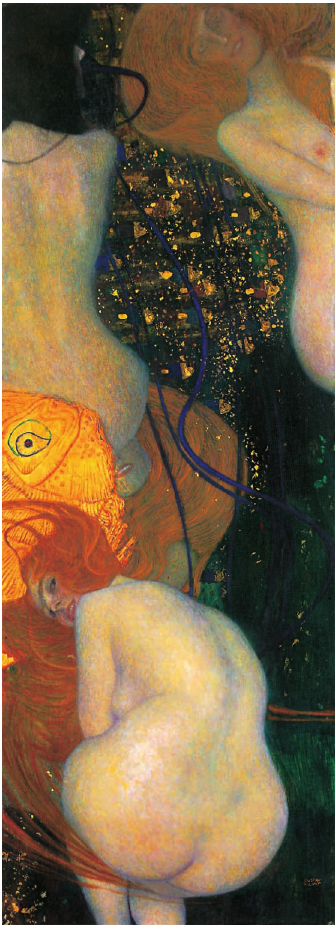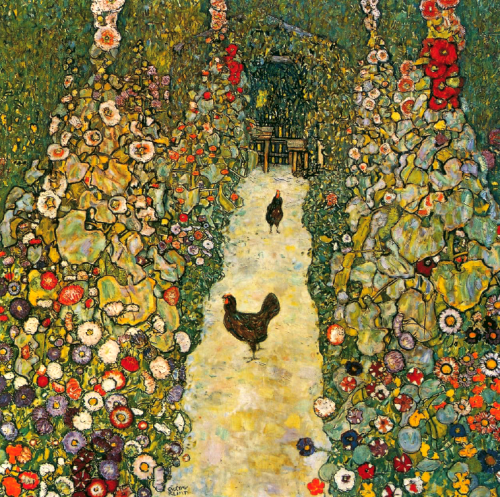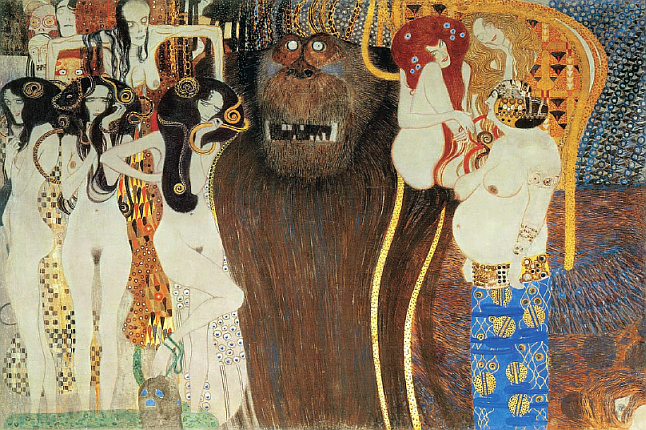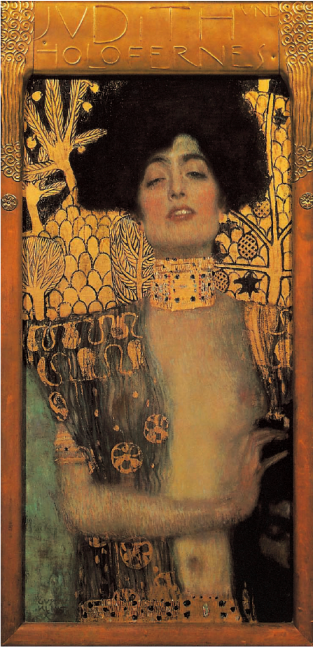Today we will be taking a look at the work of one Gustav Klimt, an Austrian painter who was a famous symbolist and Art Nouveau guy.
Klimt was born sometime during the 19th century in Schweingarten, a small hamlet near Vienna, into a family consisting of two parents and seven children, of which he was the eighth. This discrepancy always troubled the young Gustav and may very well explain why he grew up to be such a famous weirdo. His father was an inept toothpaste salesman whose meager earnings just barely kept the family out of the poorhouse ( as the gutter was known in those days ) and at the age of fifteen, sick of eating toothpaste three times a day, Klimt ran away from home and joined the Kunstgewerbeschule, an art school the name of which was so bewildering even to Austrians that everyone just referred to it as “The Place Across From Hans Grubber’s Sausage Shop.” Ironically, for someone who later became the leader of a rebel art movement, Klimt began his career as a painter in the rather staid and respectable academic tradition, meaning that he painted fairly realistic pictures that often used history and mythology as a poorly veiled excuse to portray hot babes in various states of undress…
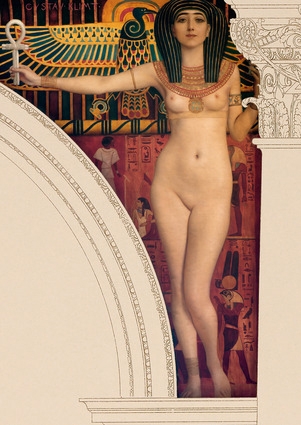
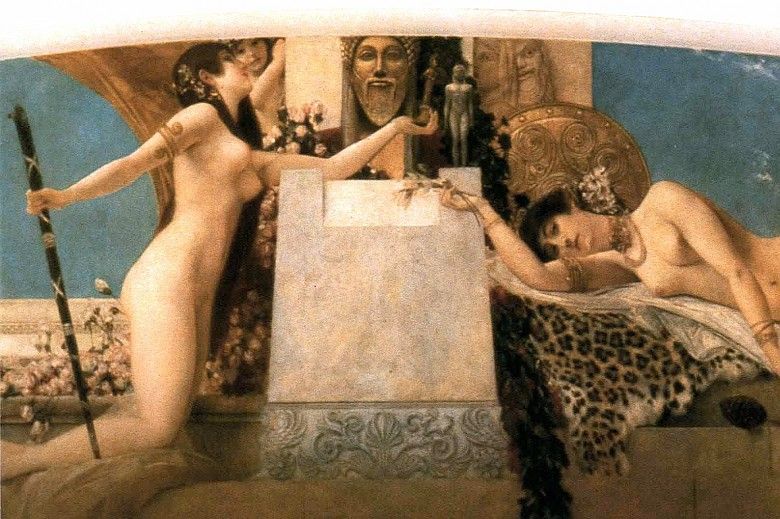
Even at this early, more conservative, stage of his career, Klimt was starting to show his radical side by frequently being photographed wearing a dress. Soon, he was not only regarded as a great painter but also as Vienna’s most famous cross-dresser…
Perhaps surprisingly for a man who spent a considerable proportion of his time wearing dresses, Klimt was, as can be clearly seen in this photograph, notoriously fond of pussy…
Klimt’s style started to veer from the academic to the radical in the 1890s, after the deaths of both his father and one of his brothers – the former died from an age-related illness, and the latter was decapitated in a tragic haircutting accident. Soon, Klimt would become the leader of a bunch of Austrian nutjobs known as The Vienna Secession. At first Klimt joined the group because he was under the impression that they were some sort of dance troupe. When it was explained to him that they were in fact a bunch of avant-garde painters trying to shake up the establishment he was disappointed but nonetheless decided to stay, partly because he sympathized with their goals, and partly because he noticed that there were an unusual number of naked women standing around. Before you know it, Klimt was turning out some stunningly ornate paintings that blended depictions of the female figure with weird and colorful mosaic-like patterns…
The most famous of these, though I personally don’t care for it – I feel it looks too much like a penis – is this thing called “The Kiss.” Created from a combination of oil paint and gold leaf, this work depicts a man trying to eat some woman’s face during the Austrian Strudel Famine of 1866. The depiction of such a disturbing theme proved highly controversial and led to Klimt being banned not only from several galleries but also from his local hat blocker’s workshop.
This next one is called “Goldfish,” and portrays three very small women whom Klimt kept in an aquarium in his studio. The women are thought to be some sort of pixie mermaid native to the Rhine, but I don’t know the species of the goldfish itself, nor do I know how he felt about having to share his home with such unusual interlopers. The figure at the base of the composition has been acknowledged by Spinal Tap lead guitarist David St. Hubbins as the inspiration for the band’s 1984 rock classic “Big Bottom.”
Next up is a piece entitled “Garden Path with Scary Chicken.” One can deduce from the title that Klimt found only one of these chickens scary, though which one remains a mystery. Though this may seem an unlikely subject for Klimt, it is in fact part of a series of chicken paintings that he was asked to do by his therapist in an attempt to deal with his lifelong fear of chickens – much in the same way that Van Gogh dealt with his fear of bread by creating dozens of paintings of wheat fields. The rest of these chicken paintings have unfortunately not survived, having been amongst the numerous Klimt works that were destroyed by the SS at Immendorf Castle towards the end of the war, the SS being, as any historian will tell you, notorious chicken-haters and a bunch of bastards completely lacking in any aesthetic sense.
Now we have what is easily the creepiest thing Klimt ever painted, at least of the 3 or 4 I have looked at. Entitled “Water Sprites,” this depicts a pair of disembodied heads who liked to float around Vienna’s famous Amalienbad public swimming pool looking to devour stray fishermen. As Vienna is landlocked and therefore has few fishermen, the two were rarely successful and this is thought to explain why they have wasted away to nothing but a pair of freaky-looking heads. Given Klimt’s well-known preference for red-heads it is notable that both women are brunettes – this suggests that he does not like these women, perhaps having confused them with chickens.
The following work is “Das Grosse Affe und die Nackte Frauen” which translates into English as “King Kong and the Bare-naked Ladies,” part of the famous Beethoven frieze, a piece Klimt created to honor the works of the great Austrian composer Johann Strauss, the Younger. The three figures on the left are thought to be the mythical Gorgons as they have snakes in their hair – notice once again his use of black hair to signify female evil. The redheaded woman on the right is thought to be Klimt’s main squeeze Emilie Flöge, a hot tamale whose hotness is signified by her red hair. I don’t know who the blonde is, probably just some girl who wandered into the studio when he was painting the thing. The big fat woman was for a long time thought to be Klimt’s mother-in-law until everyone remembered that Klimt had never married. She is now thought to be his Czechoslovakian landlady Olga Zázvorková, who gave him a break on the rent in return for occasionally being able to ruin one of his paintings.
The great mystery, of course, is the inclusion of King Kong as the center of the piece. Some have suggested that it is not King Kong at all but rather Donald Trump. This is a ridiculous suggestion for two reasons. First, Donald Trump had not yet been born when the painting was created, and second, Donald Trump has never been that handsome. Which brings us back to King Kong. My suspicion is that Klimt, possibly during one of his summer holidays, traveled to Skull Island and there met Kong, a fellow with whom he shared an obvious penchant for scantily clad babes. The two got along so well that on his return to Europe Klimt decided to sneak Kong into one of his paintings, surrounding him with the naked babes of which the big banana muncher was so fond.
Lastly we have 1901’s “Judith and the Head of Holofernes.” In this painting, Klimt depicts the great Jewish heroine with the freshly severed head of the Assyrian general Holofernes, hence the otherwise inexplicable title of “Judith and the Head of Holofernes.” As part of a systematic system of oppression instituted by his boss Nebuchadnezzar, Holofernes had been annoying the people of Judith’s town by denying them access to the Kosher bakery where they bought their bagels.
After several days of this foolishness, Judith decided something had to be done. Late one night, she put on a pink Teddy and some fluffy pink slippers, grabbed a sack full of cheese and wine and headed to Holofernes’ tent. After knocking (as this was a tent, the knocking was not done in the usual manner but instead consisted of the would-be guest uttering loudly the words “Knock, knock, knock,” until they were given entry) and being invited in by the unsuspecting general, Judith gave Holofernes the old “Hey, big boy, is that a bag of shekels in your pocket or are you just glad to see me?” treatment and soon Holofernes realized he was about to get lucky. Unfortunately for him, as soon as he turned around to apply some cologne to his beard, Judith thumped him on the noggin with the cheese-and-wine-filled bag and then proceeded to hack his head off with a guillotine which she always carried for such emergencies. She then went back to her town where she became so celebrated a figure that she eventually wound up in a possibly apocryphal section of the bible. The moral of the story is a simple one – “Don’t mess with Judith’s bagels.” Or is it “Never turn your back on a woman with cheese?” I’m not sure. If there is a rabbi in the audience, please email me.


